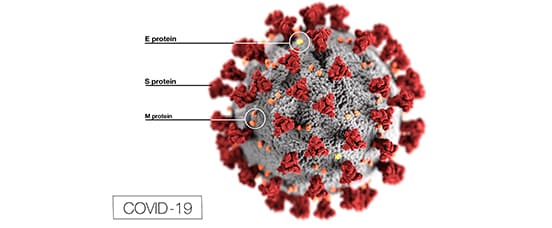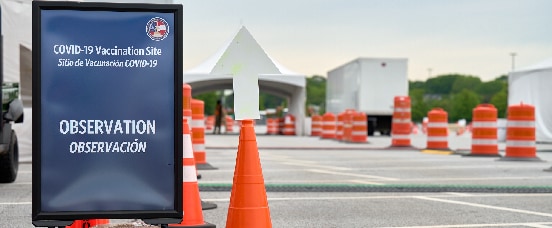The David J. Sencer CDC Museum is temporarily closed.
Continue to check our website for further updates on when we will reopen. When the museum reopens, all visitors will need to make reservations at least a week in advance. Walk-in visits are no longer permitted.
CDC Timeline
2020s

2020
- CDC maps America’s high levels of physical inactivity
- Public health screenings begin at three U.S. airports for 2019 novel coronavirus (2019-nCoV)
- CDC activates Emergency Operations Center (EOC) on Monday, January 20, to support public health partners responding to the outbreak caused by a novel (new) coronavirus first identified in Wuhan, Hubei Province, China
- CDC confirms person-to-person spread of new coronavirus in the United States
- A CDC-developed laboratory test kit to detect 2019 novel coronavirus (2019-nCoV) begins shipping to select qualified U.S. and international laboratories
- The World Health Organization (WHO) names the new disease COVID-19
- CDC launches the SARS-CoV-2 Sequencing for Public Health Emergency Response, Epidemiology, and Surveillance (SPHERES) consortium, expanding the use of whole-genome sequencing (WGS) of the COVID-19 virus
- June 25 marks the end of the 2018 Ebola outbreak in the eastern part of DRC
- CDC discovers active ingredient, nootkatone, for development of new mosquito/tick insecticides and repellents
- CDC launches a national campaign, Hear Her, which highlights warning signs of pregnancy-related death
- Africa is declared free of wild poliovirus, the second virus eradicated from the continent since smallpox 40 years previously
- Field Epidemiology Training Program (FETP) celebrates its 40th anniversary
- CDC investigates a multi-state outbreak of Salmonella Stanley infections linked to wood ear mushrooms

2021
- January 12, 2021
CDC expands the COVID-19 negative test requirement to include all air passengers entering the U.S. CDC continues to recommend that people test again 3-5 days after arrival and stay home for 7 days after traveling to help slow the spread of COVID-19.- CDC Expands Negative COVID-19 Test Requirement to All Air Passengers Entering the United States
- January 20, 2021
Dr. Rochelle Walensky begins her term as the director of the CDC with the goal of rapidly accelerating COVID-19 testing, surveillance, and vaccination, while confronting the public health challenges posed by suicide, substance use disorder and overdose, chronic diseases, and the tolls caused by social and racial injustice and inequity. - January 25, 2021
New data from the CDC estimates that, at any given time in the U.S., 1 in 5 people have a sexually transmitted infection (STI). - January 30, 2021
As part of the Biden Administration’s Executive Order on Promoting COVID-19 Safety in Domestic and International Travel, CDC requires face masks to be worn by all travelers while on public transportation and inside transportation hubs to prevent the spread of COVID-19 effective February 2, 2021. - February 12, 2021
CDC investigates fast-moving, muti-state outbreak of Listeria monocytogenes infections linked to fresh and soft cheeses. - March 8, 2021
CDC recommends that people who are fully vaccinated against COVID-19 can safely gather with other fully vaccinated people indoors without masks and without socially distancing.- CDC Issues First Set of Guidelines on How Fully Vaccinated People Can Visit Safely with Others
- March 18, 2021
A CDC funded research initiative offers access to optimally fluoridated water for up to 19 million people in the U.S. for the first time. - April 1, 2021
CDC investigates a multi-state Salmonella outbreak, linking the likely source of the infections to contact with wild songbirds and bird feeders.- CDC Investigation Notice: CDC investigating Salmonella outbreak linked to wild songbirds
- April 7, 2021
CDC and the Substance Abuse and Mental Health Services Administration (SAMHSA) announces that federal funding may now be used to purchase rapid fentanyl test strips (FTS) in an effort to combat a spike in drug overdose deaths driven by the use of synthetic opioids, including illicitly manufactured fentanyl.- Federal Grantees May Now Use Funds to Purchase Fentanyl Test Strips
- April 23, 2021
The Advisory Committee on Immunization Practices (ACIP) and U.S. Food and Drug Administration (FDA) jointly recommend the continued use of the Johnson & Johnson COVID-19 vaccine for all people ages 18 years and older in the U.S., following a thorough safety review after the use of the vaccine was paused when 6 cases of rare and severe type of blood clots were reported. - May 12, 2021
The Advisory Committee on Immunization Practices (ACIP) recommends the Pfizer-BioNTech COVID-19 vaccine for all adolescents ages 12–15 years.- CDC Director Statement on Pfizer’s Use of COVID-19 Vaccine in Adolescents Age 12 and Older
- May 14, 2021
A large CDC study following health care personnel in 33 states finds that mRNA COVID-19 vaccines are highly effective in preventing SARS-CoV-2 infections in real-world conditions, reducing the risk of infection by 94 percent.- Largest CDC COVID-19 Vaccine Effectiveness Study in Health Workers Shows mRNA Vaccines 94% Effective
- June 30, 2021
CDC’s National Breast and Cervical Cancer Early Detection Program reports that the total number of cancer screenings decreased by an average of 87% for breast cancer and 84% for cervical cancer during early 2020 due to the COVID-19 pandemic, putting individuals at risk for delayed diagnoses and poorer health outcomes.Sharp Declines in Breast and Cervical Cancer Screening - July 30, 2021
CDC releases data in The Morbidity and Mortality Weekly Report (MMWR) showing an increase in breakthrough infections of COVID-19 in Barnstable County, Massachusetts in July of 2021. The early data showing high viral loads in people infected with the Delta variant of COVID-19 suggest a concern that, unlike with other variants, vaccinated people infected with Delta can transmit the virus to others. This MMWR becomes the most wildly circulated report in the agency’s history. - August 2, 2021
CDC extends Title 42, the order suspending the right to introduce non-citizen persons into the U.S. at the nation’s southern and northern land borders during the COVID-19 pandemic, with the exception of the unaccompanied non-citizen children exempt under a July 16, 2021 order.-
- CDC Extends Order at the Southern and Northern Land Borders
Title 42 Order Reassessment and Exception for Unaccompanied Noncitizen Children
-
- August 3, 2021
Amid a growing surge of the Delta variant, CDC Director Dr. Rochelle Walensky signs an extension of the eviction moratorium in areas of substantial and high COVID-19 transmission in recognition that eviction moratoria, like quarantine, isolation, and social distancing, can be effective public health measures taken to prevent the spread of a communicable disease like COVID-19.- CDC Issues Eviction Moratorium Order in Areas of Substantial and High Transmission
- August 18, 2021
The U.S. Department of Health and Human Services, the U.S. Food and Drug Administration, and CDC release a statement concluding that booster shots of the Pfizer-BioNTech, Moderna, and Johnson & Johnson COVID-19 vaccines will be needed to protect against severe disease, hospitalization, and death in the coming months.- Joint Statement from HHS Public Health and Medical Experts on COVID-19 Booster Shots
- August 18, 2021
CDC launches the new Disease Forecasting Center to advance the use of forecasting tools and outbreak analytics in public health decision making.- CDC Stands Up New Disease Forecasting Center
- August 30, 2021
The Advisory Committee on Immunization Practices (ACIP) recommends Pfizer-BioNTech’s COVID-19 vaccine for all people ages 16 years and older. - September 29, 2021
CDC releases a Health Alert Network (HAN) Health Advisory to notify clinicians and public health authorities of the need to increase COVID-19 vaccination rates among women who are pregnant, breastfeeding, or who are trying to become pregnant. View the HAN. - October 26, 2021
Laboratory testing at CDC identifies the cause of a melioidosis outbreak, a rare bacteria found in an aromatherapy spray: Burkholderia pseudomallei.- CDC Identifies Rare Bacteria in Aromatherapy Product
- October 28, 2021
The Advisory Committee on Immunization Practices’ (ACIP) updates blood lead reference value for children after a recommendation by the Lead Exposure Prevention and Advisory Committee (LEPAC). - November 2, 2021
The Advisory Committee on Immunization Practices (ACIP) recommends the Pfizer-BioNTech pediatric COVID-19 vaccine for all children ages 5–11 years.- CDC Recommends Pediatric COVID-19 Vaccine for Children 5 to 11 Years
- November 10, 2021
CDC and the World Health Organization (WHO) report that more than 22 million infants missed their first dose of the measles vaccine in 2020. This is the largest global increase of unvaccinated children in two decades and is due in-part to the disruptions the COVID-19 pandemic has had on health care and immunization services.- Global Progress Against Measles Threatened Amidst COVID-19 Pandemic
- Immunization coverage
- November 18, 2021
CDC analyzed data from the National Violent Death Reporting System (NVDRS) to help uncover the characteristics of homicides of American Indian and Alaska Native (AI/AN) people, finding that 53% were killed in metropolitan areas, a firearm was used in 48% of homicides, and for female victims, 38% of suspects were current or former intimate partners.- CDC’s National Violent Death Reporting System Helps Tell the Story of Homicides of American Indian and Alaska Native People
- December 7, 2021
CDC establishes two new networks—the Global Action in Healthcare Network (GAIHN) and the Global AR Laboratory and Response Network (Global AR Lab & Response Network), to combat antimicrobial resistance.CDC Launches Two Global Networks, Awards $22 Million to Combat Antimicrobial Resistance and Infectious Diseases
- January 12, 2021

2022
- March 31, 2022
CDC releases data from the Adolescent Behaviors and Experiences Survey (ABES) showing that from January 2021 – June 2021 among high-school aged adolescents: 44% report feeling persistently sad or hopeless; 55% report emotional abuse in the home; 11% report physical abuse in the home; and 29% report job loss by an adult in the home. Lesbian, gay, bisexual, and female youth reported the poorest overall mental health, the most emotional abuse by a parent or caregiver, and attempted suicide more their peers during the COVID-19 pandemic. - April 1, 2022
CDC announces the termination of Title 42, an Order that suspended the right to introduce migrants into the U.S. during the COVID-19 pandemic, effective May 23, 2022. - April 19, 2022
CDC launches the new Center for Forecasting and Outbreak Analytics (CFA). The CFA will use data, infectious disease modeling, and analytics to improve CDC and its public health partners’ responses to emerging public health threats. - April 22, 2022
Researchers at CDC’s National Institute for Occupational Safety and Health (NIOSH) identify a new rare but serious occupational health disease among metalworkers: welder’s anthrax, a pneumonia caused by the bacteria that produces anthrax toxin. - May 10, 2022
During the COVID-19 pandemic, CDC finds that there has been a 35% increase in the firearm homicide rate, the highest rate in more than 25 years. Firearm homicide rates are the highest among males, adolescents, young adults, and non-Hispanic Black and non-Hispanic American Indian and Alaska Native people. Rates of firearm suicide remain elevated, increasing most notably among American Indian and Alaska Native males ages 10–44, and are highest in rural areas.
- May 18, 2022
CDC’s National Center for Immunization and Respiratory Diseases (NCIRD) investigates an outbreak of acute hepatitis of unknown cause in children under 10 years of age.
- May 25, 2022
CDC releases data in the Morbidity and Mortality Weekly Report (MMWR) showing that COVID-19 survivors are twice as likely to develop a pulmonary embolism or respiratory condition and that approximately 1 in 5 adults currently have at least one health condition that may be attributable to a previous COVID-19 infection. - June 9, 2022
CDC investigates the first known Listeria outbreak in the U.S. linked to enoki mushrooms. - June 23, 2022
In addition to a steep reduction in HIV diagnoses and slowing in pre-exposure prophylaxis prescriptions from 2019 to 2020, CDC data show a sharp decrease in the number of CDC-funded HIV tests administered during the first year of the COVID-19 pandemic. - June 28, 2022
On Tuesday, June 28, 2022, CDC activates its Emergency Operations Center (EOC) to support public health partners responding to the Mpox virus outbreak in nine states. - July 12, 2022
The National Institute for Occupational Safety and Health (NIOSH) offers free and confidential black lung screenings for coal miners in Kentucky, Virginia, and West Virginia. - August 10, 2022
CDC and the Agency for Toxic Substances and Disease Registry (ATSDR), in partnership with the Department of Health and Human Services’ Office of Environmental Justice, release the first national, geographic-driven tool designed to measure the cumulative impacts of environmental burden in the U.S. through the lenses of human health and health equity: the Environmental Justice Index (EJI). - August 31, 2022
CDC finds that the expansion of telehealth services during the COVID-19 pandemic was positively associated with individuals experiencing opioid use disorder staying in treatment longer and reducing their risk of experiencing a medically treated overdose. - August 31, 2022
Average life expectancy in the U.S. has fallen for the second year in the row– for the first time in 100 years. In 2021, life expectancy declined by 1.9 years for Non-Hispanic American Indian-Alaskan Native (AIAN) people, 1.0 years for White people, 0.7 years for Black people, 0.2 years for Hispanic people, and 0.1 years for Asian people. From 2019 – 2021, AIAN people’s life expectancy declined by a total of 6.6 years, and in 2021, AIAN people had a life expectancy at birth of 65.2 years– the life expectancy of the general U.S. population in 1944. - September 13, 2022
After a case of paralytic polio in an unvaccinated adult and several positive wastewater samples are found in Rockland County, N.Y., CDC confirms that there is circulating vaccine-derived poliovirus in the U.S. - September 19, 2022
CDC releases data showing that more than 4 in 5 pregnancy-related deaths in the U.S. are preventable. - October 18, 2022
CDC and public health partners track a multi-state Salmonella outbreak using data from the PulseNet system and whole genome sequencing to link the outbreak to pet bearded dragons. - October 20, 2022
The Advisory Committee on Immunization Practices (ACIP) recommends updates to the 2023 childhood and adult routine immunization schedules, including approved COVID-19 vaccines. - November 30, 2022
CDC plans to expand wastewater testing for the polio virus in select communities across the U.S. - December 21, 2022
CDC, the U.S. Food and Drug Administration (FDA), the Texas Department of State Health Services, and other public health partners, investigate a multistate outbreak of norovirus illnesses linked to raw oysters from Texas. - December 22, 2022
CDC releases a Health Alert Network (HAN) Health Advisory to notify clinicians and public health authorities of a recent increase in pediatric infections of invasive group A streptococcal (iGAS).
- March 31, 2022